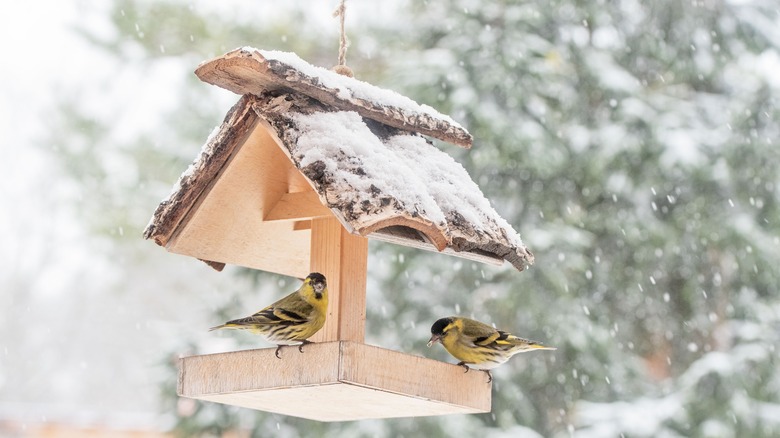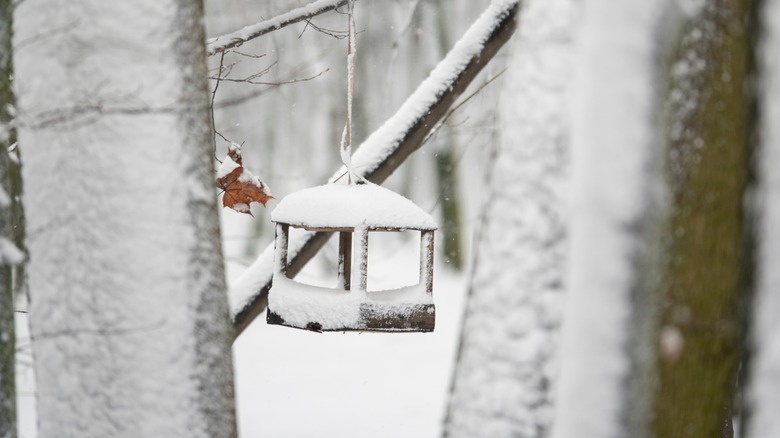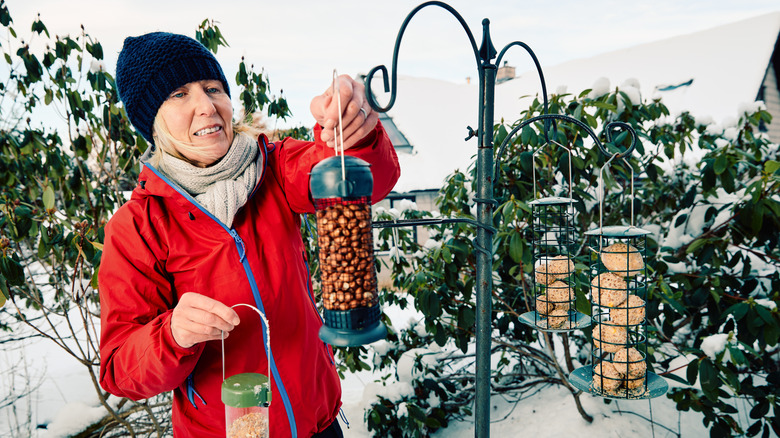The One Thing You Should Do To Your Bird Feeder Before A Snow Storm Hits
If you live in an area prone to winter snowstorms, it's a good idea to protect your bird feeder from the elements and cover it ahead of bad weather. The good news is that doing so is as simple as grabbing a plastic bag.
The Humane Society of the United States notes that winter is when birds rely on feeders the most. As such, it's paramount to keep them out when snowy weather hits. That said, there's no denying that snow can wreak havoc on feeders and their contents — entrances can get snowed in, and seeds can become waterlogged and even dangerous for bird consumption. In light of that, it's best to prevent snow from getting into your feeder in the first place. Naturally, the way you'll go about it will depend on the type of feeder you have and where it's placed in your yard. However, arguably the easiest, most adaptable way to deflect snow from your feeder is wrapping it in a plastic bag.
It's easy enough to do in the first place, and super simple to remove once the snow has passed. What's more, if you have a bunch of plastic bags lying around the house, you may not even need to spend anything to prevent damage to your birds' food this winter.
Measure your bird feeder and take it from there
First thing's first: You'll need to take a look at the size and shape of your specific bird feeder. Of course, some feeders will be easier to cover in a plastic bag than others. Such is the case with hanging, tube-style feeders. Simply place the bottom of the feeder into a bag, and tie the handles together at the top. The same goes with mounted tube feeders, though depending on how your feeder is mounted, you may need to tie the handles at the bottom. The same approach can work for other types of feeders in other shapes, too, especially if they're on the smaller side.
You've got a bigger bird feeder? That's no problem. You can get creative with whatever you have lying around: bags from online orders, or even trash bags can work. As with a traditional plastic bag, you'll also need to play around with how you get the bag over the feeder. You can do the same with tray-style feeders, too — which is just as well, as they stand to face the most damage in a snowstorm. Alternatively, you can pull out the big guns and use some plastic wrap. Simply wrap the feeder until it's completely covered. And no need to worry about being non-eco-friendly: Among other retailers, Amazon stocks compostable cling wrap for less than $10.
However you choose to cover your feeder once the snowstorm has passed, get that bag or wrap off, and save it for the next storm.
Remove the plastic as soon as the storm passes
While plastic bags and wraps can help a lot during heavy snowfall, it's important to remove the plastic as soon as the snow ends. After all, the goal of a bird feeder is to feed the birds, so preventing them from being able to access food when they need it most is counterproductive.
Anticipating heavy snow on and off for a few days and don't want to deny your birds some food during breaks in the snowstorm? You could also look into a different solution. If you're able to move your feeder, place it under a tree or anything else that could offer some covering from the snow. If it's mounted in place, or you don't have a tree or some kind of overhang, another option is to use a baffle. You can attach a large baffle — available on Amazon for under $25 — to the top of the feeder to act as a shelter. That said, if the snow is falling at an angle or swirling, you'll need to go out and make sure any wet seed is removed and that birds still have easy access.
However you choose to protect your bird feeder from the elements this winter, be sure to top it up regularly, with seasonally appropriate, fatty foods. Your birds will thank you.


